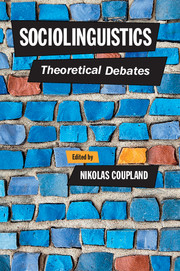Book contents
- Frontmatter
- Contents
- List of contributors
- Preface and acknowledgements
- 1 Introduction: Sociolinguistic theory and the practice of sociolinguistics
- Part I Theorising social meaning
- 2 The “push” of Lautgesetze, the “pull” of enregisterment
- 3 Variation, meaning and social change
- 4 Indexicality, stance and fields in sociolinguistics
- 5 Sociolinguistic differentiation
- Part II Language, markets and materiality
- Part III Sociolinguistics, place and mobility
- Part IV Power, mediation and critical sociolinguistics
- Part V Sociolinguistics, contexts and impact
- Part VI The evolution of sociolinguistic theory
- Index
- References
2 - The “push” of Lautgesetze, the “pull” of enregisterment
from Part I - Theorising social meaning
Published online by Cambridge University Press: 05 June 2016
- Frontmatter
- Contents
- List of contributors
- Preface and acknowledgements
- 1 Introduction: Sociolinguistic theory and the practice of sociolinguistics
- Part I Theorising social meaning
- 2 The “push” of Lautgesetze, the “pull” of enregisterment
- 3 Variation, meaning and social change
- 4 Indexicality, stance and fields in sociolinguistics
- 5 Sociolinguistic differentiation
- Part II Language, markets and materiality
- Part III Sociolinguistics, place and mobility
- Part IV Power, mediation and critical sociolinguistics
- Part V Sociolinguistics, contexts and impact
- Part VI The evolution of sociolinguistic theory
- Index
- References
Summary
Without question the enterprise of linguistics was decisively transformed, in Leipzig, Halle, and elsewhere, by what flowed from the comparative-historical study of Indo-European and other recognized language families. By the last quarter of the nineteenth century, serious scholars in the discipline sought to base generalizing theories about the nature of language on these results, intending to make the speculative philosophizing of Enlightenment savants disappear in the brighter and better light of empirical generalizations about language change that evidence, in turn, how language must function. By the post–Great War twentieth century, language change itself, once the central focus of linguistics – “diachrony” of linguistic systems, in Ferdinand de Saussure's terminology – came to be viewed counterdirectionally through the lens of “synchronic” structural states immanent in the actualized forms and functions of language. And indeed, for the rest of the century until the current day, the presumption of such immanent structural systematicity in relation to the actualized and experienced forms and functions of language has played the central role in investigating language change. Understood as change of the way forms code denotational meanings of language, it is seen as an inevitable outcome of the universal fact of variation in discursive performance within a language community. The synchronically based reimagination of Neogrammarian Lautgesetze has been in this respect variationist sociolinguistics’ key affordance, both in phonology and, more problematically, beyond.
In light of a Foucauldian genealogy of ideas, I will counterpose a more semiotically and social anthropologically informed view of what is termed “variation” in terms of indexicality – the quality of signs such as phonetic parameters to point to aspects of their context of production and reception – and of variation's enregisterment – the frequently only intuitively felt property of textual (“stylistic”) coherence of indexical and other compatible signs one with another in the flow of discourse that defines an abstractable schema, a subgrammar, for context-appropriate and context-effective modes of communicating. Observe that enregisterment partially structures the norms immanent in any measurable indexical effects in the real-time use of language by filtering such indexicality through the lens of form in denotational code.
- Type
- Chapter
- Information
- SociolinguisticsTheoretical Debates, pp. 37 - 67Publisher: Cambridge University PressPrint publication year: 2016
References
- 44
- Cited by



